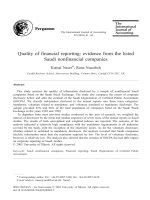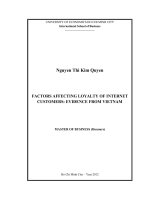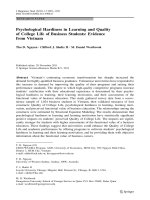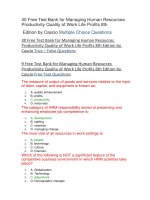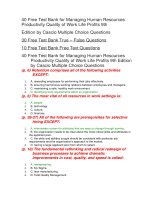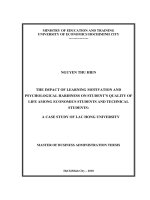Psychological capital, burnout, and quality of work life: evidence from Vietnam
Bạn đang xem bản rút gọn của tài liệu. Xem và tải ngay bản đầy đủ của tài liệu tại đây (881.53 KB, 57 trang )
UNIVERSITY OF ECONOMICS HO CHI MINH CITY
International School of Business
------------------------------
Nguyen Hong Mai
PSYCHOLOGICAL CAPITAL, BURNOUT,
AND QUALITY OF WORK LIFE:
EVIDENCE FROM VIETNAM
MASTER OF BUSINESS (Honours)
Ho Chi Minh City – Year 2016
UNIVERSITY OF ECONOMICS HO CHI MINH CITY
International School of Business
------------------------------
Nguyen Hong Mai
PSYCHOLOGICAL CAPITAL, BURNOUT,
AND QUALITY OF WORK LIFE:
EVIDENCE FROM VIETNAM
MASTER OF BUSINESS (Honours)
SUPERVISOR: Dr. Nguyen Thi Mai Trang
Ho Chi Minh City – Year 2016
Acknowledgement
I would like to express my sincere gratitude to my supervisor Dr. Nguyen Thi Mai Trang
for the continuous support of my research, for her patience, motivation, and immense
knowledge. Her guidance helped me in all the time of research and writing of this study.
In addition, I would like to thank my family and my friends for supporting me spiritually
throughout writing this study. Therefore, I dedicate this work as a gift to them all.
1
Abstract
The present study investigates the impacts of psychological capital on burnout and
quality of work life of employees in Vietnam. The study based on positive organizational
behavior theory to propose a model in which psychological capital has impacts on
burnout and quality of work life. This research also examines the roles of burnout in
quality of work life. The model was tested with a sample of 302 employees working for
firms in Ho Chi Minh City by means of structural equation modeling. The results show
that the proposed model fits the data well and all hypotheses were supported. The test
confirms that psychological capital has positive impacts on quality of work life and
negative impacts on burnout of employees. These findings verify the importance of
psychological capital in work and lives in a transitioning market. Hence, psychological
capital is important for enhancing employee’s quality of work life and reducing job
burnout. In addition, firms should pay attention to this type of capital in their recruiting,
training and career development programs.
Keywords
psychological capital, quality of work life, burnout, Vietnam
2
TABLE OF CONTENTS
ACKNOWLEDGEMENT
ABSTRACT
TABLE OF CONTENTS
LIST OF FIGURES
LIST OF TABLES
1. INTRODUCTION ........................................................................................................... 6
2. LITERATURE REVIEW AND HYPOTHESIS ............................................................. 8
2.1 Conceptual model .......................................................................................................... 8
2.2 Psychological capital ..................................................................................................... 9
2.3 Burnout ........................................................................................................................ 11
2.4 Quality of work life ..................................................................................................... 12
2.5 Moderating effects of demographics ........................................................................... 15
3. METHODOLOGY ........................................................................................................ 16
3.1 Design and Sample ...................................................................................................... 16
3.2 Measurement ............................................................................................................... 19
3
3.3 Measurement refinement ............................................................................................. 22
4. DATA ANALYSIS AND RESULT ............................................................................. 23
4.1 Measurement validation .............................................................................................. 23
4.2 Psychological capital ................................................................................................... 24
4.3 Burnout ........................................................................................................................ 24
4.4 Quality of work life ..................................................................................................... 25
4.5 Saturated model ........................................................................................................... 28
4.6 Hypothesis testing........................................................................................................ 31
5. DISCUSSION ................................................................................................................ 31
5.1 Implications ................................................................................................................. 32
5.2 Limitations and directions for future research............................................................. 34
4
LIST OF FIGURES
Figure 1: Conceptual model ................................................................................................ 8
Figure 2: Structural results (standardized estimates) ........................................................ 30
LIST OF TABLES
Table 1: Sample characteristics ......................................................................................... 18
Table 2: Measurement scale .............................................................................................. 21
Table 3: Means, standard deviations, and standardized CFA loadings of items ............... 26
Table 4: Unstandardized structural paths in the model ..................................................... 29
5
1. Introduction
In today’s world, one of the fundamental strategic parts of an organization is human
resource. Human resource can increase the resource capability of an organization in order
to meet its objectives and for future growth (Armstrong, 2010). Human is also one of the
most significant functions in economic productivity (Gavin & Mason, 2004). In order to
get through the tough business environment and maintain sustainable growth, firms need
to find out new methods to human resource management (Luthans, Norman, Avolio &
Avey, 2008). Researchers have focused on two components of the working people in
recent years (Nguyen & Nguyen, 2012). The first component is the positive
organizational behavior and its derivative psychological capital, which is described as an
individual’s psychological state of development (Luthans et al., 2008) and the quality of
work life is the second component (Sirgy, 2006; Wright & Cropanzano, 2004).
Researchers show that there is a relationship between psychological capital and quality of
work life (Nguyen & Nguyen, 2012; Nguyen, Nguyen & Minh, 2014) and a relationship
between psychological capital and burnout (Luo & Hao, 2010; Luthans, Luthans &
Luthans, 2004). Nevertheless, little information remains on the relationships between
psychological capital, quality of work life, and burnout, notably in developing countries.
Moreover, the role of psychological capital and quality of work life of staff members has
not gained much awareness by researchers in developing nations like Vietnam (Nguyen
& Nguyen, 2012; Nguyen, Nguyen & Minh, 2014). Thus, the purpose of this study is to
investigate the roles of psychological capital in quality of work life and burnout of
6
employees in Vietnam. In addition, this research also investigates the moderating roles of
age and gender in the relationships between psychological capital, quality of work life,
and burnout.
In the 1990s, Vietnam started to build its economy after many years of war and
post-war readjustment. Highly skilled workforce is required during the process of change
toward a market-oriented economy and integration into the global economic main stream.
However, it is very challenging for Vietnam’s employers to attract and retain qualified
employees (Bodewig, Badiani-Magnusson & Macdonald, 2014). Therefore,
understanding the relationship between employee psychological capital, burnout and
quality of work life will help firms in designing appropriate policies for staffs and will
allow them to recruit qualified people. All of this could result in a happier and healthier
workforce leading to a healthier, more successful and profitable organization. This study
is organized around the following key points: introduction; literature review and
hypotheses; research method, data analysis, and results; discussion and implications;
limitations and directions for future research.
7
2. Literature review and hypotheses
2.1. Conceptual model
Figure 1 proposes a conceptual model clarifying roles of psychological capital in burnout
and quality of work life, the model proposes that psychological capital of employees will
have negative impacts on burnout and positive impacts on quality of work life. In
addition, burnout will have negative impacts on quality of work life of staff members.
This study also examines the moderating effects of demographic characteristics (age and
gender) on the relationships between psychological capital, quality of work life, and
burnout.
Demographics
Gender
Age
H4ab
Burnout
Psychological
Capital
H2
Quality of
Work Life
Figure 1. Conceptual model
8
2.2. Psychological capital
Psychological capital is a multidimensional construct referring to a positive psychological
state of development of an individual (Luthans, Youssef & Avolio, 2007). Not many
organizational behavior researchers have paid much attention to trait-like personality and
state-like psychological capacities of employees. Trait-like personality is more likely to
be solid over time and is not specific to any task or situation, however state -like
psychological capacities are more likely to adapt over time and are more specific to
certain situations or tasks (Chen, Gully, Jon-Andrew & Kilcullen, 2000). Psychological
ownership (Avey, Avolio, Crossley & Luthans, 2009) and psychological capital (Luthans
et al., 2008) are conceptions that outline state-like psychological capacities of staff
members. These conceptions can be discovered in the literature of positive organizational
behavior. This study focuses on psychological capital of employees.
Hope, efficacy, optimism, and resilience are four positive constructs that have
been determined to best fit the criteria of the definition of positive organization behavior
until now (Luthans, 2002; Luthans et al., 2007), whereas various positive constructs have
been studied (Cameron, Dutton, Quinn & Wrzesniewski, 2003; Nelson & Cooper, 2007).
Psychological capital is defined as “an individual’s positive psychological state of
development that is characterized by: (1) having confidence (self-efficacy) to take on
and put in the necessary effort to succeed at challenging tasks; (2) making a positive
attribution (optimism) about succeeding now and in the future; (3) persevering toward
goals and, when necessary, redirecting paths to goals (hope) in order to succeed; and (4)
9
when beset by problems and adversity, sustaining and bouncing back and even beyond
(resiliency) to attain success” (Luthans et al., 2007, p. 3). According to Luthans et al.
(2008), psychological capital has received both conceptual and empirical support.
Snyder, Irving, and Anderson (1991) defined hope as a “positive motivational
state that is based on an interactively derived sense of successful (1) agency (goaldirected energy) and (2) pathways (planning to meet goals)” (p. 287). Hope indicates “the
belief that one can find pathways to desired goals and become motivated to use those
pathways” (Snyder, Rand & Sigmon, 2002, p. 257). This psychological source
progressively contributes hope that the objective will be achieved. Agency and pathways
thinking are both significant and reciprocal factors of hope. Applying hope to the
professional level in a company, hopeful employees express the remarkable ability to
develop numerous pathways to attain their goals.
The second positive construct of psychological capital is optimism. It was
characterized by Carver and Scheier (2002) that “optimists are people who expect good
things to happen to them; pessimists are people who expect bad things to happen to
them” (p. 231). This explanation describes the expectancy framework used to distinguish
optimistic people and pessimistic people in an organization. Applied to the professional
level, optimistic staff members are people who have positive expectations of results
(Luthans et al., 2008). Regardless of personal ability, optimistic staffs expect positive
results for themselves. Hence, the optimistic employees have forward looking beliefs
regardless of past issues or setbacks.
10
A third positive construct of psychological capital is self-efficacy. It is people’s
determination in their capacity to accomplish a specific goal in a specific condition.
Peoples trusts about their abilities to generate designated levels of performance that
exercise affect over events that influence their lives and decides how people feel, think,
stimulate themselves and behave (Judge, Jackson, Shaw, Scott & Rich, 2007). Applying
self-efficacy to the professional level, staffs with high efficaciousness are described by
tenacious pursuit and persistent efforts toward achievement and are directed by trusts in
their own successes.
The fourth positive construct forming psychological capital is resilience. Luthans
(2002) defined resilience as a “positive psychological capacity to rebound, to bounce
back’ from adversity, uncertainty, conflict, failure, or even positive change, progress and
increased responsibility” (p. 702). Applying resilience to the professional level in a firm,
employees are those who have the ability to positively adapt and thrive in very
challenging circumstances.
2.3. Burnout
Maslach, Jackson, and Leiter (1996) defined burnout as a syndrome of exhaustion,
depersonalization and reduced professional efficacy. Firstly, emotional exhaustion is
obtained when staff members feel severe emotional fatigue and diminished or no
ambition against the employment. Exhaustion is the central quality of burnout and the
11
most obvious manifestation of this complex syndrome (Maslach, Schaufeli & Leiter,
2001).Of the three aspects of burnout, exhaustion is the most widely reported and the
most thoroughly analyzed. However, the fact that exhaustion is a necessary criterion for
burnout does not mean it is sufficient (Maslach, 2003). Secondly, cynicism is
accomplished when employees get away from work and indicate an indifferent and
callous attitude at firms. Lastly, reduced personal accomplishment is attained when
people feel a lack of competence and successful work accomplishment.
Currently, only some research has analyzed the relationship between
psychological capital and job burnout (Luo & Hao, 2010; Luthans et al., 2004).
Psychological capital plays a crucial role in the development of job burnout and that it
can productively decrease the extent of burnout (Luthans et al., 2004). Luo and Hao
(2010) discovered proof for the preventative impact of psychological capital on job
burnout by using Chinese nurses as attendants. Nevertheless, the body of research
regarding the relationship between psychological capital and job burnout stays relatively
small, especially in staff members. Therefore, we propose the following hypothesis:
H1: Psychological capital has a negative impact on burnout.
2.4. Quality of work life
Quality of work life is defined as an employee satisfaction with a variety of needs
through resources, activities, and outcomes stemming from participation in the workplace
12
(Sirgy, Efraty, Siegel & Lee, 2001). Studies demonstrate that employees with a high
quality of work life tend to report high levels of identification with their organizations,
job satisfaction, job performance and lower levels of turnover and personal alienation
(Efraty, Sirgy & Claiborne, 1991). Marta et al. (2013) indicated one conceptualization of
quality of work life, based on need-hierarchy theory of Maslow, concerns quality of work
life as employee satisfaction of seven sets of human developmental needs: (1) health and
safety needs, (2) economic and family needs, (3) social needs, (4) esteem needs, (5)
actualization needs, (6) knowledge needs, and (7) esthetic needs. Quality of work life was
conceptualized in terms of need satisfaction stemming from an interaction of employee’s
needs (survival, social, ego and self-actualization needs) and those organizational
resources relevant for meeting them.
Arandjelovic, Nikolic, and Stamenkovic (2010) showed that burnout, quality of life
and work ability are significantly interrelated categories in food manufacturing workers. In
addition, Anagnostopoulos and Niakas (2010) indicate that burnout not only may
negatively impact on quality of life of health-care providers but also may influence short
sick leaves. Karisalmi (1999) examined the relationship of burnout and the quality of
working life in retail trade and metal industry. Results revealed that six dimensions of the
quality of working life, namely: conflicts, job control, work of superior organization of
work and monotonous job had different impacts on job burnout in both the retail trade and
in the metal industry. Employee burnout is expected to have a negative impact on their
quality of work life. Therefore, we propose the following hypothesis:
13
H2: Burnout has a negative impact on quality of work life.
Past study shows that psychological capital is positively related to employees’
psychological health and job satisfaction (Luthans, Avolio, Walumbwa & Li, 2005).
Research also demonstrates that these four components (self-efficacy, optimism, hope,
and resiliency) of psychological capital have positive relationships with performance,
happiness, well-being, and satisfaction of employees. For instance, self-efficacy has been
discovered to have a positive effect on performance (Stajkovic & Luthans, 1998).
Employees’ optimism is linked to their performance, satisfaction, and happiness (Youssef
& Luthans, 2007). Hope is connected with employees’ performance, satisfaction,
happiness, and retention (Youssef & Luthans, 2007). Resiliency has a positive
relationship with employee performance and happiness and satisfaction (Youssef &
Luthans, 2007). In general, self-efficacy, optimism, hope, and resiliency are connected to
the quality of work life of workers (Nguyen & Nguyen, 2012; Nguyen et al., 2014).
Compare with its individual components, psychological capital overall is a better
predictor of staff performance (Luthans, Youssef & Avolio, 2007). Hence, in this
research, the author concentrates on the anticipating power of psychological capital
overall rather than its individual parts. The author also proposes that overall
psychological capital may have positive impact on quality of work life of employees.
Thus, the third hypothesis was proposed as following:
H3: Psychological capital has a positive impact on quality of work life.
14
2.5. Moderating effects of demographics
The moderating impacts of demographic characteristics (age and gender) on the
relationships between psychological capital, quality of work life, and burnout had studied
in this paper. Not many research has investigated the connection between demographic
variables and psychological capital as a core construct (Avey, Nimnicht & Graber
Pigeon, 2010). Even though no researchers have predicted male-female differences in
psychological capital, related research findings offer at least suggestive evidence that
there may be crucial gender differences. For instance, past papers present male-female
differences in levels of resilience that men are more resilient than women (Bonanno,
2004). If women consistently vary from men on some components of psychological
capital, there may be differences in the factor structure by gender. Furthermore, age and
psychological capital were significantly linked in a negative direction (Avey, Nimnicht &
Graber Pigeon, 2010). Results of analyses of covariance of the effects of gender and job
level on burnout components, while controlling for tenure, indicated no significant
differences between men and women in the amount of emotional exhaustion,
depersonalization or personal accomplishment (Pretty, McCarthy & Catano, 1992).
Particularly, women are likely to be more emotionally exhausted than men, but men are
likely to be more depersonalized than women (Purvanova & Muros, 2010). Overall, it
occurs that employee demographic characteristics have an impact on the relationships
between psychological capital, quality of work life, and burnout. Therefore, the following
hypotheses were proposed:
15
H4a: The impacts of psychological capital on both burnout and quality of work
life and the impact of burnout on quality of work life are weaker for male employees than
for female employees.
H4b: The impacts of psychological capital on both burnout and quality of work
life and the impact of burnout on quality of work life are weaker for younger employees
than for older employees.
3. Methodology
3.1. Design and sample
The research consists of two stages, a pilot and a main survey, and was conducted in Ho
Chi Minh City, the main business centre of Vietnam. Participators are employees
working for companies in Ho Chi Minh City. The pilot study was implemented in the
qualitative stage. We conducted a series of in-depth interviews with 5 employees working
for 5 different companies in Ho Chi Minh City to modify the measures. Although most of
the measures of constructs are available in the literature, this step is important to make
them appropriate for the context of this study (a transition market). Google Forms and
face-to-face interviews were used to undertake the main survey. A total of 115
questionnaires were released to employees of various firms in Ho Chi Minh City through
Google Forms. After one week, there were 112 feedbacks from respondents. However, 10
questionnaires were not valid because respondents did not finish the questions or they
chose the same answer for all questions. Therefore, 102 valid questionnaires were
16
collected from Google Forms. Meanwhile, a total of 230 questionnaires were sent to
employees of seven firms in Ho Chi Minh City through printed questionnaires. Seven
firms included three state – owned companies, three joint – stock companies and one
private company. After two weeks, there were 215 feedbacks from respondents.
However, 15 questionnaires were not valid because respondents did not answer all of the
questions or they chose the same answer for all questions. Therefore, 200 valid
questionnaires were collected from printed questionnaires. As a result, 302 valid answers
could be used to analyze. The respondents were a diversity of age, gender, education, etc.
as descriptive data was showed in Table 1. This main survey aims to validate the
measures and test the structural model. Confirmatory factor analysis (CFA) is applied to
assess the measures and structural equation modeling (SEM) is used to test the theoretical
model and hypotheses.
17
Table 1. Sample characteristics
Gender
Age
Education
Tenure
Position level
Specialization
Type of firm
Size of firm
Category
Male
Female
18 to 25
26 to 35
36 to 45
Older than 45
High School
College
University
Master Degree
Doctoral Degree
Others
1 – 6 months
7 months – 2 years
3 – 5 years
6 – 10 years
Over 10 years
Junior Staff
Senior Staff
Manager
Others
Accounting/ Finance
Admin/Human Resources
Sales/Marketing
Arts/Media/Communications
Computer/Information Technology
Education/Training
Customer service
Others
State – owned company
Joint – stock company
Joint – venture company
Limited proprietary company
Private company
Others
<100 employees
100 – 300 employees
>300 employees
18
Frequency
109
193
30
139
70
63
10
28
212
47
2
3
25
71
53
59
94
90
158
36
13
114
42
27
21
8
9
22
59
142
70
9
2
45
34
72
36
194
Percentage (%)
36.1%
63.9%
9.9%
46%
23.2%
20.9%
3.3%
9.3%
70.2%
15.6%
7%
1%
8.3%
23.5%
17.5%
19.5%
31.1%
29.8%
52.3%
11.9%
4.3%
37.7%
13.9%
8.9%
7%
2.6%
3%
7.3%
19.5%
47%
23.2%
3%
0.7%
14.9%
11.3%
23.8%
11.9%
64.2%
3.2. Measurement
There are three constructs investigated in this study: psychological capital, quality of
work life, and burnout. All of the constructs are second-order constructs. Psychological
capital comprised four elements: hope; optimism; resiliency; and, self-efficacy. Hope was
measured by four items acquired from Snyder, Rand, and Sigmon (2002). Note that state
hope is utilized in this study (Snyder et al., 2002). Optimism was measured by three items
borrowed from Carver and Scheier (2002). Resiliency was measured by four items,
followed from Block and Kremen (1996). Self-efficacy was measured by four items,
borrowed from Parker (1998). Quality of work life was measured by nine items focusing
need satisfaction of staffs (Sirgy et al., 2001). Quality of work life contained three items
which are survival needs, belonging needs, knowledge needs. Seven-point Likert scaling,
anchored by 1 (strongly disagree) and 7 (strongly agree) was used for psychological
capital and quality of work life in this study. Job burnout contained three dimensions
which are exhaustion, cynicism and professional efficacy mainly based on Maslach
Burnout Inventory-General Survey (Maslach et al., 1996). As suggested by Schutte,
Toppinen, Kalimo, and Schaufeli (2000), one item (“When I’m at work or I’m working I
don’t want to be bothered”) was eliminated because it was shown to be ambivalent and
thus unsound. Seven-point Frequency rating scale, ranging from 1 (never) to 7 (always)
was used to collect the responses of burnout.
19
The questionnaire was initially prepared in English and then translated into
Vietnamese by an academic fluent in both languages. This procedure was undertaken
because English is not well understood by all employees in this market.
20
Table 2. Measurement scales
Variables
Screening
Question
Hope
Code
S1
Are you currently employed?
HOPE1
HOPE3
At the present time, I am energetically pursuing my goals in
work.
There are a lot of ways around any problem that I am facing
in work now.
I can think many ways to reach my current goals in work.
OPT1
In uncertain times in work, I usually expect the best.
OPT2
I always expect things go to my way.
OPT3
Overall, I expect more good things to happen to me.
RES1
I quickly get over and recover from being startled in work.
RES2
I am generous with my colleagues.
RES3
I get over my anger at someone reasonably quickly.
SELF1
I feel confident of analyzing a long-term problem to find a
solution in work.
SELF2
I feel confident of presenting my work area in meetings with
senior Management.
SELF3
I feel confident of contacting people outside the company.
SELF4
SUR1
I feel confident of presenting information to a group of
colleagues.
My job provides good medical benefits.
SUR2
I am satisfied with what I’m getting paid for my work.
SUR3
My job does well for my family.
BELO1
I have good friends at work.
BELO2
Away from work, I have enough time to enjoy other things
in life.
BELO3
I feel appreciated at work.
KNOW1
I feel that my job allows me to realize my full potential.
KNOW2
My job allows me to sharpen my professional skills.
KNOW3
My job helps me develop my creativity.
HOPE2
Optimism
Resiliency
Self-efficacy
Survival needs
Belonging
needs
Knowledge
needs
Item
21
Reference
Snyder,
Rand, and
Sigmon
(2002);
Carver and
Scheier
(2002);
Block and
Kremen
(1996) ;
Parker (1998)
Sirgy et al.
(2001)
Variables
Code
Item
Exhaustion
EXHA1
I feel emotionally drained by my work.
EXHA2
I feel used up at the end of a day at the company.
EXHA3
EXHA4
I feel tired when I get up in the morning and I have to go to
work.
Working is really a strain for me.
EXHA5
I feel burned out from my work.
CYN1
CYN2
I have become less interested in my work since my join in
the company.
I have become less enthusiastic about my work.
CYN3
I’ve become more cynical about the use of my work.
CYN4
I doubt the significance of my work.
EFF1
I can efficiently solve the problems that arise in my work.
EFF2
EFF3
I believe that I make an effective contribution to the
company.
In my opinion, I am a good employee.
EFF4
I feel stimulated when I reach my work goals.
EFF5
I learned many interesting things during my work
EFF6
During working I feel confident that I am effective in getting
things done.
Cynicism
Professional
Efficacy
Reference
Maslach,
Jackson and
Leiter (1996)
3.3. Measurement refinement
The measures were refined via Cronbach’s alpha reliability and EFA, using the data
collected from 302 employees in the main survey. Specifically, EFA (principal
components with varimax rotation) extracted four factors from the items measuring
psychological capital with 71.217 percent of variance extracted. The Cronbach’s alpha
scores for these scales were .734 (hope), .793(optimism), .745 (resiliency), and .879 (selfefficacy). EFA extracted three factors from 9 items measuring quality of work life with
22
79.869 percent of variance extracted. The Cronbach’s alpha scores for these scales were
.841 (survival needs), .761 (belonging needs), and .892 (knowledge needs). Note that 1
item measuring survival needs (My job provides good medical benefits) was deleted due
to their low item-total correlations (<.30) in the reliability analysis. Finally, EFA
extracted three factors from the items measuring burnout with 69.923 percent of variance
extracted. The Cronbach’s alpha scores for these scales were .889 (exhaustion), .896
(cynicism), and .882 (professional efficacy). In sum, the results of the preliminary
assessment indicated that all scales satisfied the requirement for reliability.
4. Data analysis and results
4.1. Measurement validation
As earlier presented, three constructs were examined: psychological capital, burnout, and
quality of work life. The scales measuring these constructs were refined via Cronbach’s
alpha and EFA using the data set (n = 302) collected in the main survey. These scales
were then accessed via CFA using the data set (n = 302). Two steps were undertaken in
validating measures. First, a CFA model was used to assess the constructs (psychological
capital, burnout and quality of work life). Next, the three second-order constructs
(psychological capital, burnout, and quality of work life) were incorporated into a
saturated model (final measurement model).
23


